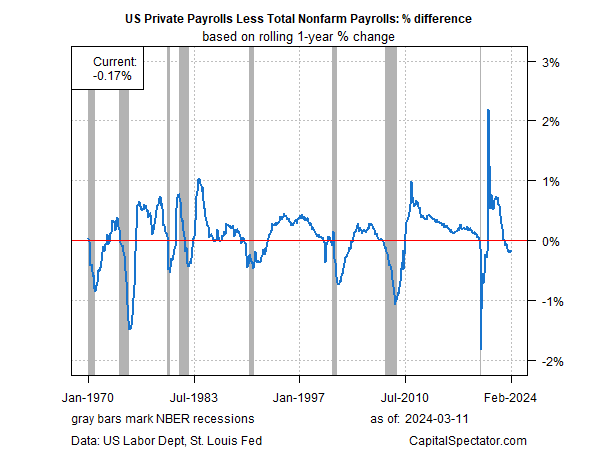Is the Labor Market as Strong as It Appears?
James Picerno | Mar 11, 2024 08:21
Friday’s payrolls data for February dispatched another upside surprise, reaffirming the now-consensus view that recession risk is low for the US economy.
Hiring rose 275,000 last month, beating expectations — well above the consensus forecast for around 200,000.
A closer look at the numbers, however, paints a mixed picture. As The Wall Street Journal noted,
“Behind the headline number were signs of a gradual slowdown.”
Nonetheless, there’s still a strong case for expecting the labor market to expand at a healthy if slower pace. But there are also hints that as the year unfolds, hiring headwinds could increase, perhaps more than expected.
One possible early warning: the private-sector component continues to underperform relative to the aggregate level, which includes government jobs.
The distinction is important because private firms are responsible for the overwhelming share of hiring (and firing). Companies are also sensitive to the business cycle vs. the relative immunity to staffing in government.
In short, measuring the difference in the year-over-year change in total payrolls vs. its private counterpart is revealing. Most of the time, the year-over-year change in private hiring exceeds hiring in total payrolls.
That’s not surprising since companies expand their payrolls in line with a growing economy (which tends to prevail most of the time), and shift into reverse when economic headwinds increase.
Although several key indicators for payrolls continue to reflect strength, the recent slide in year-over-year private payrolls vs. the aggregate number is worrisome, as the chart below shows.

A net negative reading often coincides with a recession. The fact that this metric has been negative for 11 straight months through February raises a possible warning flag for the labor market and the economy.
The good news: this indicator, to the extent it signals trouble, tends to be early. Another pushback is that several so-called reliable business-cycle indicators have faltered recently, and so it’s possible (likely?) that this caveat applies here too.
Modeling the outlook for the year-over-year change in private payrolls with a different methodology suggests that the chart above is overstating the potential risk.
Using CapitalSpectator.com’s ensemble model for projecting the 1-year trend private payrolls continue to anticipate low risk for the labor market in the near term.
That’s also the implied forecast in the low level of initial jobless claims, which continue to print near multi-decade lows.
If and when this leading indicator starts to rise in a meaningful, sustained degree, that would confirm the warning sign in the first chart above.
For what it’s worth, the relative weakness in private payrolls vs. total payrolls is telling us that jobless claims will soon rise, although that seems like a low-probably event today.
Trading in financial instruments and/or cryptocurrencies involves high risks including the risk of losing some, or all, of your investment amount, and may not be suitable for all investors. Prices of cryptocurrencies are extremely volatile and may be affected by external factors such as financial, regulatory or political events. Trading on margin increases the financial risks.
Before deciding to trade in financial instrument or cryptocurrencies you should be fully informed of the risks and costs associated with trading the financial markets, carefully consider your investment objectives, level of experience, and risk appetite, and seek professional advice where needed.
Fusion Media would like to remind you that the data contained in this website is not necessarily real-time nor accurate. The data and prices on the website are not necessarily provided by any market or exchange, but may be provided by market makers, and so prices may not be accurate and may differ from the actual price at any given market, meaning prices are indicative and not appropriate for trading purposes. Fusion Media and any provider of the data contained in this website will not accept liability for any loss or damage as a result of your trading, or your reliance on the information contained within this website.
It is prohibited to use, store, reproduce, display, modify, transmit or distribute the data contained in this website without the explicit prior written permission of Fusion Media and/or the data provider. All intellectual property rights are reserved by the providers and/or the exchange providing the data contained in this website.
Fusion Media may be compensated by the advertisers that appear on the website, based on your interaction with the advertisements or advertisers.